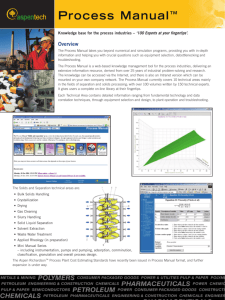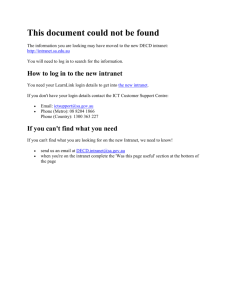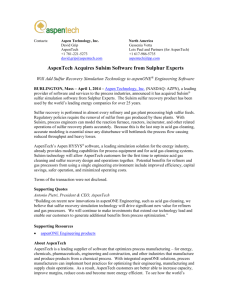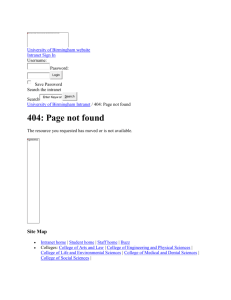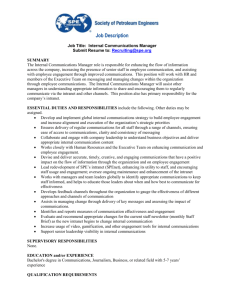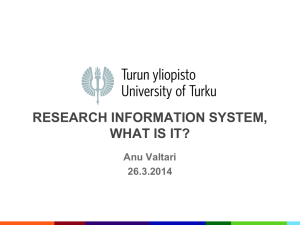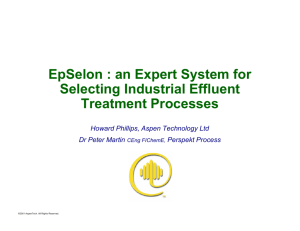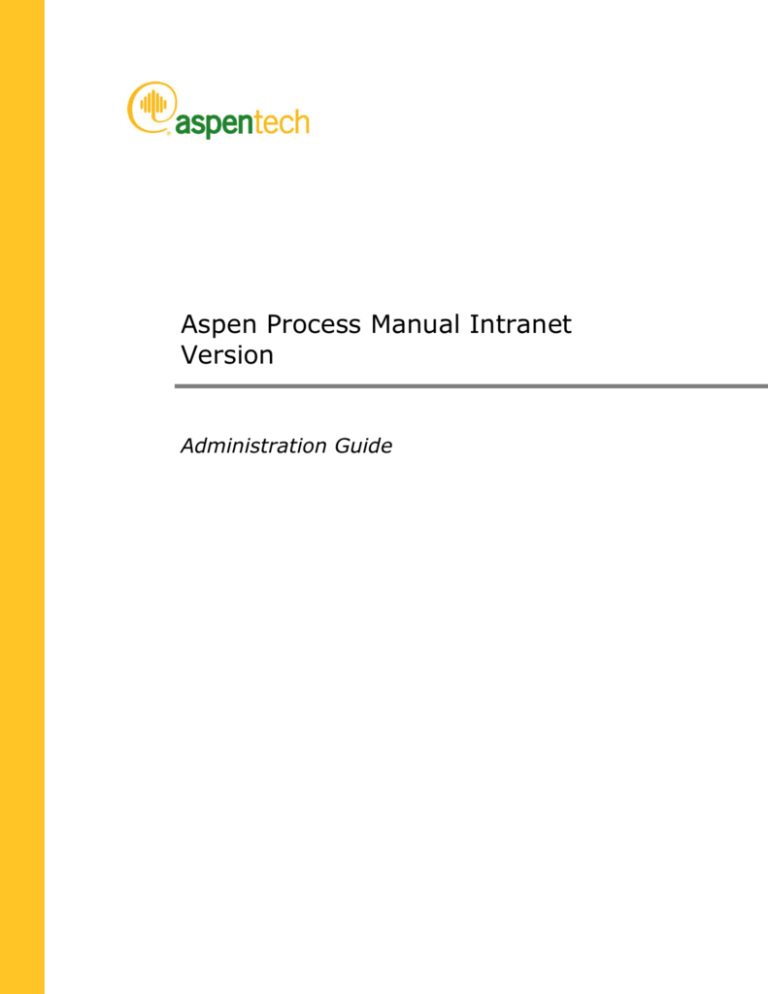
Aspen Process Manual Intranet
Version
Administration Guide
Version Number: V7.3
March 2011
Copyright (c) 2011 by Aspen Technology, Inc. All rights reserved.
Process Manual Intranet Version, the aspen leaf logo, and Plantelligence & Enterprise Optimization are trademarks
or registered trademarks of Aspen Technology, Inc., Burlington, MA.
All other brand and product names are trademarks or registered trademarks of their respective companies.
This document is a guide for using AspenTech's software. This documentation contains AspenTech proprietary and
confidential information and may not be disclosed, used, or copied without the prior consent of AspenTech or as set
forth in the applicable license agreement. Users are solely responsible for the proper use of the software and the
application of the results obtained.
Although AspenTech has tested the software and reviewed the documentation, the sole warranty for the software
may be found in the applicable license agreement between AspenTech and the user. ASPENTECH MAKES NO
WARRANTY OR REPRESENTATION, EITHER EXPRESSED OR IMPLIED, WITH RESPECT TO THIS
DOCUMENTATION, ITS QUALITY, PERFORMANCE, MERCHANTABILITY, OR FITNESS FOR A PARTICULAR
PURPOSE.
Aspen Technology, Inc.
200 Wheeler Road
Burlington, MA 01803-5501
USA
Phone: 1 781 221 4300
http://www.aspentech.com
Contents
About this Document .......................................................................................... 1
Related Documentation ..................................................................................... 1
Online Technical Support Center ........................................................................ 1
Phone and E-mail ............................................................................................. 2
Introducing the Intranet Process Manual ................................................................3
The Technical Areas .......................................................................................... 3
Applied Rheology ................................................................................... 3
Bulk Solids Handling ............................................................................... 4
Crystallization ........................................................................................ 4
Drying .................................................................................................. 4
Gas Cleaning ......................................................................................... 5
Slurry Handling ...................................................................................... 5
Solid Liquid Separation ........................................................................... 5
Solvent Extraction .................................................................................. 5
Waste Water Treatment .......................................................................... 6
Mini Manual Series ................................................................................. 6
Manual Development .............................................................................. 6
1 Introduction and Organization ............................................................................7
Server Machine ................................................................................................ 7
Directories ...................................................................................................... 8
Administration Pages ........................................................................................ 8
2 Configuration ......................................................................................................9
Internet Information Server............................................................................... 9
Licensing ......................................................................................................... 9
3 Web Application ................................................................................................10
4 Troubleshooting ................................................................................................13
5 Error Messages ..................................................................................................14
ALnnn ........................................................................................................... 15
ARnnn .......................................................................................................... 16
BRnnn .......................................................................................................... 17
CDnnn .......................................................................................................... 19
LEnnn ........................................................................................................... 20
UNnnn .......................................................................................................... 21
Contents
iii
About this Document
This guide details Process Manual administration procedures and should be
read by users installing, configuring, or maintaining the system on a server.
Further information about the Process Manual and functionality is contained in
the on-line help available from the Help menu option within the application.
Related Documentation
In addition to this document, the following documents are provided to help
users learn and use this application.
Title
Content
Aspen Engineering Suite Installation Guide
Full installation procedures for this
release of the Process Manual found
in the Installation Guide (found on
the Documentation DVD).
User Guide
This guide provides an overview of
the Process Manual features and
how to use them.
On-line Help
A comprehensive on-line help
system detailing all aspects of the
Process Manual application.
Online Technical Support
Center
AspenTech customers with a valid license and software maintenance
agreement can register to access the Online Technical Support Center at:
http://support.aspentech.com
You use the Online Technical Support Center to:
Access current product documentation.
Search for technical tips, solutions, and frequently asked questions
(FAQs).
Search for and download application examples.
Search for and download service packs and product updates.
Submit and track technical issues.
Search for and review known limitations.
Send suggestions.
Introducing the Intranet Process Manual
1
Registered users can also subscribe to our Technical Support
e-Bulletins. These e-Bulletins proactively alert you to important technical
support information such as:
Technical advisories.
Product updates.
Service Pack announcements.
Product release announcements.
Phone and E-mail
Customer support is also available by phone, fax, and e-mail for customers
who have a current support contract for their product(s). Toll-free charges are
listed where available; otherwise local and international rates apply.
For the most up-to-date phone listings; please see the Online Technical
Support Center at:
http://support.aspentech.com
2
Support Centers
Operating Hours
North America
8:00 – 20:00 Eastern time
South America
9:00 – 17:00 Local time
Europe
8:30 – 18:00 Central European time
Asia and Pacific Region
9:00 – 17:30 Local time
Introducing the Intranet Process Manual
Introducing the Intranet
Process Manual
The Process Manual is an Intranet knowledge management tool for the
process industries. It enables chemists and chemical engineers in either plant
operation, engineering contracting or equipment supply companies to access
valuable chemical engineering knowledge from their desk.
The Process Manual is derived from the considerable body of knowledge that
has been developed by the SPS (Separation Processes Service) Consultants
over 25 years of industrial problem solving and research. The Process Manual
is composed of nine Technical Areas:
Applied Rheology
Bulk Solids Handling
Crystallization
Drying
Gas Cleaning
Slurry Handling
Solid Liquid Separation
Solvent Extraction
Waste Water Treatment
Mini Manual Series
The Technical Areas
Applied Rheology
Rheology fundamentals. Summary of typical data for wide range of industrial
materials. Estimation of viscosity data. Review of, and recommended
procedures for, five widely-used viscometric geometries for viscosity and flow
curve measurement. Estimation of shear rate and shear stress for specific
industrial applications to ensure relevance of viscosity and flow measurement
with respect to application. Review of flow curve models and fitting data to
selected model. Yield stress definition, measurement and application.
Introducing the Intranet Process Manual
3
Definitions of time-dependent flow behaviour. Review of, and
recommendations for, methods for measuring and modelling thixotropy.
Description of linear and non-linear viscoelasticity, including transient
dynamic properties (creep compliance, recoil function, stress relaxation
modulus, stress growth coefficient and stress decay coefficient) and
oscillatory dynamic properties (complex rigidity modulus, complex shear
viscosity, complex shear compliance and loss tangent). Normal stress and
elongational (extensional) viscosity. Review and selection of commerciallyavailable laboratory and on-line viscometers and rheometers. Review of
commercially-available index viscometers and possible applications. Effect of
key physical and chemical properties on suspension, polymer and emulsion
rheology. Use of rheology as a tool for process engineering design, plant
troubleshooting, quality control and product formulation. Industrial case
studies on use of rheological data.
Bulk Solids Handling
Metering and feeding and pumps for wet cakes. Survey of screw and vibratory
conveyors, design guide for screw conveyors and selection guide for
mechanical conveyors. Review of vacuum and pressurized air systems. State
of the art and design guide for gravity transfer chutes. Survey & selection
guide for valves. Review of moisture measurement methods, selection of
moisture measurement methods & survey of level measurement. Techniques
to improve bulk solids handling and a review of powder mixing. Survey of
storage options for bulk solids & design guide for wet or dry bulk solids in
hoppers, silos, bins and bunkers. State-of-the-art review of laboratory
measurement and a survey of shear testers for bulk solids.
Crystallization
An overview of industrial crystallization, crystal nucleation and growth, habit
modification, agglomeration and organic solvent selection. Data needed for
equipment selection, process design, operation and troubleshooting.
Concentration and supersaturation. Crystal size and shape, crystallization
kinetics. Selecting the equipment to use and integration with up-stream and
downstream plant. Selecting batch or continuous operation, and
supersaturation generation route. Batch and continuous equipment, scale-up,
pumps, agitators and control. Simulation of batch and continuous
crystallizers. Tailoring the crystal size distribution. Crystal purity, encrustation
in crystallizers. Chiral crystallization, sonocrystallization and other novel
developments. Solubility measurement, crystal size and shape, measurement
and literature searching, development techniques.
Drying
Fundamentals of drying theory, industrial drying practice and equipment.
Dryer selection: rules and algorithm, small-scale tests, heat and mass
balances, approximate sizing procedures. Equipment description, detailed
theoretical background and design/performance calculation guide for:
fluidized bed dryers (including fluid bed granulation and vibro-fluidization),
rotary dryers, spray dryers and atomization, pneumatic conveying (flash)
4
Introducing the Intranet Process Manual
dryers, layer and contact dryers (including tray, plate, agitated, tumbling and
vacuum types), RF and microwave dryers. Drying kinetics and equilibria:
theory and practical application. Product quality and powder stickiness.
Safety, control, instrumentation and troubleshooting. Recommended
procedures.
Gas Cleaning
Selection of equipment type, cyclones, wet dedusters, electrostatic
precipitators, depth and rigid filters, fabric filters, mist removal. Types,
operation, science and design of: cyclones, wet dedusters, electrostatic
precipitators, fabric filters and mist removal. VOC abatement, dioxin and
furan formation, adsorbent selection, SOx and NOx removal. Fire and
explosion, hostile & difficult conditions, stringent conditions, high temperature
and pressure, sampling and measurement, optical dust monitors,
troubleshooting. Fans, dampers, ducts, hoods and compressors.
Slurry Handling
Review and selection of pumps for slurries and pastes including metering
pumps. Review of pipeline design for slurries and pastes and methods for
settling and non-settling slurries, pipeline-cleaning techniques. Vacuum and
pressurized air systems for slurry transport, design guide for non-settling
slurry transport using vacuum or air. Review of slurry flow in open channels
and launders. Selection and state of the art review of valves for slurry.
Minimization of wear in slurry systems. Level measurement techniques,
viscosity and other rheological techniques, slurry flowmeters, moisture
measurement, density & passive acoustic emission monitoring. State of the
art review and selection/design guide for powder-liquid mixing. Review of
slurry tank design, commercially available slurry agitators & design of slurry
storage systems. Equipment and methods for measuring relevant properties
of slurries for handling applications.
Solid Liquid Separation
Selection and sizing of the optimum equipment type for a specific separation,
instrumentation, flocculation & coagulation, discharge of cakes, filter aids,
filter media. Nutsche, drum and disc, belt, tipping pan and table, tank,
continuous pressure, filter presses, batch compression, continuous
compression, control, ancillary equipment, and performance improvement.
Crossflow filtration including microfilters, ultrafilters & dynamic filters.
Thickeners & clarifiers, classifiers, hydrocyclones, reslurry washing, efficiency
of separations, prediction of particle settling rates in different equipment
environments. Sedimenting centrifuges, filtering centrifuges & mechanical
design. Flotation, magnetic, electrical & sonic separations. Different types of
media, including their properties, selection and applications.
Solvent Extraction
Principles of selecting solvent systems, mass transfer, modes of operation,
equipment selection and design. Mass transfer and chemical reaction
Introducing the Intranet Process Manual
5
fundamentals, phase equilibrium, interfacial phenomena, coalescence and
phase separation. Contactor classification, column design, mixer-settlers,
gravity settlers, tank reactors, supercritical and high pressure processes,
membrane and liquid membrane processes, scale-up, design and simulation,
safety, environmental impact. Methodology for organics, metals and
inorganics and biotechnology applications. Recommended procedures in:
process development, phase equilibrium, interfacial tension, drop size
measurement, contactor selection, mixer batch kinetics, settler prediction,
scaling batch mixer- settlers, diffusivity measurement, mass transfer data &
extractor troubleshooting. Metals recovery processes, metals extraction,
effluent treatment.
Waste Water Treatment
Legislation, wastewater characterization, water minimization and wastewater
toxicity. A methodology for selection and live equations for estimating capital
and operating costs. Heavy metals, trace organics, anion removal, volatile
organic compounds, odor control, oil/water separation, saline streams, sludge
treatment and disposal, transport of slurries. Process selection, aerobic and
anaerobic processes, recent technical developments, `difficult' waste streams.
Precipitation, electrical processes, adsorption and ion exchange, low
temperature oxidation/reduction processes and incineration, radiation
processes. Solid-liquid separation, membrane processes and pre-treatment
techniques.
Mini Manual Series
Gas & Particle Properties: detailed practical advice on equipment and
techniques for measurement of important physical properties of gases and
solids. Adsorption: technology, available materials and underlying science of
physical bonding of liquid (adsorbate) to the surface of a microporous solid
(adsorbent). Comminution: review and practical description of particle size
reduction techniques. Classification: separation of particle flows into two or
more streams according to particle size. Overall Process Design: overview of
how to develop a solids processing flowsheet, interactions between separate
unit operations. Pumping: detailed descriptions of over 60 different pump
types with many diagrams, graphs, charts and tables.
Manual Development
We realize that knowledge needs to be refreshed and so the content of the
Process Manual is annually updated. The SPS Consultants, with the close
involvement of our customers and the academic community continue to
update and add to the content of the Process Manual.
6
Introducing the Intranet Process Manual
1 Introduction and
Organization
This manual describes the Intranet Process Manual configuration and gives
guidelines on how to administer the system. It also contains information that
will be useful to IT who may be managing server systems.
Client Machine
The Client Machine runs a standard Web Browser, such as Internet
Explorer. Internet Explorer 6 or 7 will give the best results when using the
system. As a minimum, the browser must support:
HTML 3.2
Frames
Javascript
Java applets
In addition there are two signed ActiveX controls that may be downloaded:
one for zooming images, and one for graphs. These are not essential to the
operation.
Server Machine
The bulk of the system resides on the Intranet Server. The major parts of the
system are:
Windows OS - 2000 Server or 2003 Server. Although the system can be
installed on Workstation versions of NT, 2000 or XP, these have a limited
number of allowed connections from clients compared to the Server
versions of these systems, and will only be suitable for a small user base.
Internet Information Server - this is the standard component bundled
with Windows 2000/2003 (although not necessarily installed by default).
The system has not been tested with other products that claim to support
ASP pages.
The Web Application, comprising a series of HTML and Active Server
Pages (ASPs) corresponding to the various pages that can be accessed by
the browser.
1 Introduction and Organization
7
The Document Server components deliver the content of the Process
Manual as HTML pages to the Web Application pages, and also handle
searching and equation solving. These components also access the license
pack files, which give the details of the system you have licensed.
Directories
Files are installed to subdirectories under a selectable base directory, which
defaults to Program Files\AspenTech\Aspen Process Manual <version
number>.
In the remainder of this document, paths will be referred to relative to this
base directory.
Administration Pages
These web pages allow the system to be reconfigured, and content integrated
with the server.
During installation, a shortcut to the administration pages should be installed
Start | Programs | AspenTech | Process Development
| Aspen Process Manual
| Process Manual Administration
but they can also be accessed by browsing to:
http://server/AspenTech/ProMan/proman.asp?page=admin
8
1 Introduction and Organization
2 Configuration
Internet Information Server
The Intranet Process Manual is installed as a web application within IIS. This
is done by creating a virtual directory under an existing web site; this
directory should be connected to the Aspen Process Manual <version
number>\Web directory.
The web application should be configured to have Enabled parent paths
selected (under Configure | Options in IIS).
We currently recommend running the application in a separate memory space
(high isolation level) to avoid conflicts with any other applications running.
We do not know of any such conflicts; we're just being cautious.
Licensing
The Process Manual is licensed by technical area. This information is stored in
a license file, which defines what parts of the system you are allowed to
access. Important: this file is linked to the security key, and will not operate
with another one.
It is possible to use licenses delivered from a network license server.
Refer to the Documentation DVD for further information on the AspenTech
licensing system.
2 Configuration
9
3 Web Application
The web application can be configured using the administration web page link
described earlier.
Through the administration web site (using the Admin | Configuration
menu), or through the Process Manual Administration program on the server
using the Configure | Web application menu.
This web page is divided into a number of sections.
10
3 Web Application
Links
This section contains two buttons. One transfers back to the normal welcome
page, and one displays additional debug information.
If you request support from AspenTech, you will probably be asked to provide
a copy of the debug page, as this contains information on how the system is
configured and operation.
Document server settings
This section indicates the root folder used to search for documents included in
the system. This is configured automatically at installation time.
The Re-index documents button causes the document server to re-scan this
folder (and sub-folders) for content to be included, and build an appropriate
high-level index. This needs to be done on first installation, and if the
documents are subsequently updated.
3 Web Application
11
Contact information
This section contains information which appears on pages displayed to the
user. Enter the appropriate settings and click on the Update contact
settings to save the values.
Performance and configuration
The settings control how content is rendered to users.
A description of each setting is included on screen.
Adjust the settings as required, and click on the Update performance and
configuration settings button to save them.
12
3 Web Application
4 Troubleshooting
If you have problems with system operation and wish to contact Support, it
would be helpful to include information on your system configuration.
Go to the Administration page, and click on the Display debug and status
information button. This should display a page of status information; please
save and attach or copy/paste into any email to our support staff. This will
help us to understand your specific configuration and may speed up our reply.
4 Troubleshooting
13
5 Error Messages
Most error codes generated by the application are made up of two letters
followed by three digits (for example, AL001). Descriptions of these
messages, together with some suggested corrective actions, are given in this
chapter.
14
5 Error Messages
ALnnn
Error
code
Description
AL001
Can't find the indicated DLL. Make sure you have installed the software
correctly, that all network connections are present and any CDs required
have been inserted. If the problem persists, re-install the software.
AL002
Can't load the DLL at the specified location. Make sure you have installed
the software correctly, that all network connections are present and any
CDs required have been inserted. If you have a lot of applications running,
close some down. If this fails, re-start Windows. If the problem persists,
re-install the software.
AL003
Can't link to the routine in the DLL specified. This is most likely caused by
out-of-date programs. Make sure you are running the latest version of all
the software components on your machine.
AL004
Could not unload a DLL from memory. This may be due to a problem with
the program. Try restarting Windows and trying again. If the problem
persists, contact Technical Support.
AL020
Unable to start program due to low memory or resources. Try closing
some applications. If you have been starting and stopping a lot of
programs, you may need to restart windows to free up memory.
AL021
The program file being started appears to be invalid in some way. You
could be trying to start an invalid program, or the file on disc may have
become corrupted. Try checking your disc with ScanDisk, and/or reinstalling the program.
AL022
The indicated file was not found. Try re-installing the program.
AL023
The indicated path was not found (i.e., the disc drive, network connection
or directory). Try re-installing the program.
AL024
Failed to start the program for some unexpected reason. The number
quoted should be passed to technical support if you need further
assistance.
AL025
There was an unexpected error trying to start a program, possibly due to
command-line parameters.
AL040
Failed to load the image processing library. Try re-running Setup to make
sure files are installed correctly.
AL041
Failed to find a routine in the image processing library. This is probably
caused by another application using a different version of the library.
Close other applications and then try again.
AL060
The data does not appear to be in XML format. If you are loading a file,
make sure you have selected the correct one.
AL061
An entity in an XML data stream was not recognized. You might be trying
to load non-XML data, or data from a different XML application.
AL080
An attempt was made to create a registry key using an invalid root key
prefix. Valid prefixes are HKCR, HKCU, HKLM, HKCUB and HKLMB.
AL090
An attempt was made to read past the end of a stream. If this was
associated with a file, it might indicate a corrupt file or one with an
unexpected format.
5 Error Messages
15
AL100
Security licence error. The reason code identifies the problem in greater
detail.
ARnnn
16
Error
code
Description
AR000
Evaluating the expression results in a divide-by-zero.
AR001
Evaluating the expression results in trying to take the modulus of a
number to base zero.
AR002
The expression has mismatched brackets.
AR003
The expression has an opening quote, starting an ANSI character code,
but no matching trailing quote.
AR004
An expression or term could not be recognized. The most likely reasons
are an incorrectly formatted number, a trailing operator (e.g., +), or a
miss-spelt function name. Check the expression carefully.
AR005
A hexadecimal number in the expression could not be decoded properly.
Check the number contains only the digits 0-9 and letters A-F, and is no
more than 8 characters long.
AR006
A number in the expression could not be decoded properly. Check the
expression you entered.
AR007
There did not appear to be any expression to evaluate!
AR008
You used an additional function in the expression, but with the wrong
number of parameters. Check the documentation for the function.
AR020
The internal intermediate value stack was empty when the expression
had been evaluated, and no value to return was available. This should not
normally occur. Check the expression and contact technical support if the
problem persists.
AR021
The internal intermediate value stack was not empty when the expression
had been evaluated. This should not normally occur. Check the
expression and contact technical support if the problem persists.
AR022
The arithmetic expression was too complex and the internal stack, used
to hold intermediate values when evaluating the expression, was too
small. Use a simpler expression.
AR023
The arithmetic expression could not be decoded properly. If you have
entered an expression, please check it carefully.
AR024
The arithmetic expression contained a reference to an additional function
or variable, but this was not available when the expression was
evaluated. Please contact technical support.
AR025
The arithmetic expression could not be evaluated because of an internal
error. Please quote the expression code and offset given in the error
message, together with the arithmetic expression, when contacting
technical support.
AR040
The equation supplied cannot be converted to a metafile picture
5 Error Messages
BRnnn
Error
code
Description
BR001
An unexpected exception was detected.
BR101
The Browse server component has not initialized correctly. Try reinstalling and registering it.
BR102
There does not appear to be a document registered for a particular topic
code. Check the code is correct, and if it is, check that you have
registered the document files correctly.
BR301
File xxx not found. Try re-installing, and if the problem persists report it
to your supplier.
BR351
Title not available. Try re-installing, and if the problem persists report it
to your supplier.
BR302
Documents in this area are not licensed. Contact your supplier to change
the scope of your licence.
BR401
Adjacency operators are not supported in this version of the search
engine. These include the /.../ adjacency operator, and the : paragraph
starter.
BR402
The AND (+) operator is not allowed in an adjacency (/.../) term, i.e., you
can't have (a+b)/c.
BR403
The NOT (-) operator is not allowed in an adjacency (/.../) term, i.e., you
can't have a/(not b).
BR404
The engine has been configured to not accept a space inside the search
expression.
BR405
Only word terms can precede paragraph starter (:) operator.
BR406
Unexpected end of search expression. This probably means there was an
operator at the end (e.g., +) but nothing after it.
BR407
Adjacency operator [/] not closed. These characters come in pairs
together, or separated by options.
BR408
Bracket (...) mismatch. You probably included an open bracket but not a
matching close bracket.
BR409
Word expected but not found in search term.
BR410
Can't use truncation (*) and exact (=) on the same word. Pick one or the
other.
BR411
Search term not completely decoded. There might be an operator
missing.
BR421
SIC file version does not match SII file. This is probably caused by an
incomplete installation. Please re-install.
BR422
SIC is the wrong version. Early versions of the manual files (associated
with the DOS-based Browse program) are not supported. Please remove
them and install up-to-date files.
BR431
Can't access old search data after new search has run. This is an internal
error; report the details to your supplier.
BR501
This version of the Browse server cannot load the requested document,
since it is an unsupported version. This could be caused by an out-of-date
document or server component. Make sure you are using the most up-to-
5 Error Messages
17
date files.
18
BR502
An entry in the document appears to be corrupt. Report the details to
your supplier.
BR601
Could not write to the xxx directory to store the document index.
BR602
The Browse server is being started from a non-standard application.
BR603
Only the current session user can access the Process Manual. This may
indicate a fault in the server script pages in the Intranet Process Manual.
BR604
Before an Intranet Process Manual user can access the system, they must
complete the registration information.
BR605
An Intranet Process Manual user is registered as either being passive, or
with an expired grace period, and he cannot be moved to active status.
This is probably due to your active user limit begin reached. Contact your
supplier to extend your licence limit.
BR606
The application using the Process Manual server is not licensed. To use
the Local or the Intranet Process Manual, you need the appropriate
licence enabled. Please contact your supplier to resolve this.
BR701
User identification has failed. This error should not normally occur; it if
does, please contact Support.
5 Error Messages
CDnnn
Error
code
Description
CD020
A link configuration file is an earlier version or is incompatible in some
way. It is likely that either the calling or called program is out-of-date;
please check if a more recent version is available.
CD021
Failed to load an assistant from a link dialog. This may be because the
file has not been installed.
CD022
The Assistants component, TKAssist.dll, was not registered. Check the file
is present and registered correctly, or run Setup to re-install and register
the file.
CD040
The program could not identify where it was started from. Contact
Support if this happens.
CD041
The access control component, TKAccess.dll, was not registered. Check
the file is present and registered correctly, or run Setup to re-install and
register the file.
CD060
The program ran out of memory while creating an interface list. Try
closing some applications. If you have been starting and stopping a lot of
programs, you may need to restart windows to free up memory.
CD080
The program attempted to register a COM component, but the
registration failed. Try re-installing the software. If your system
administrator has restricted your access to your machine, you may need
to contact them for assistance.
CD081
The program attempted to register a COM component, but the
registration failed. Try re-installing the software. If your system
administrator has restricted your access to your machine, you may need
to contact them for assistance.
CD082
The program attempted to unregister a COM server, but the unregistration failed. This will probably not affect your system.
CD083
The program attempted to unregister a COM server, but the unregistration failed. This will probably not affect your system. This is a
variation of CD082.
5 Error Messages
19
LEnnn
20
Error
code
Description
LE001
The value of a parameter is above or below the expected range. Check
that this is correct before proceeding with this value.
LE002
An equation does not appear to have an '=' defined. This is an internal
error, and should not occur. Please report this problem, including the
equation reference, to technical support.
LE003
The linked equation definition appears to have an isolated link reference.
This is an internal error, and should not occur. Please report this problem,
including the equation reference, to technical support.
LE004
The linked equation definition appears to have an unrecognized equation
code. This is an internal error, and should not occur. Please report this
problem, including the equation reference, to technical support.
LE010
There appears to be an error solving the equation. This could be due to
inappropriate parameter values, or an error in the equation description.
Try entering different values.
LE011
The equation-solving algorithm was unable to find a solution for the
equation. Try entering different values for the defined parameters.
LE012
The iteration limit for the equations solution has been exceeded. The
result of the equation may therefore be at worse wrong, or at best
inaccurate. Treat the results with great caution.
LE020
Some "variables" in equations may have constant values; these cannot
be changed. Do not try to reset these values.
LE021
Units entered are incompatible with the internal units of the variable.
Check and correct the units you have entered.
5 Error Messages
UNnnn
Error
code
Description
UN001
Can't find the units definition file. Check that network connections /
required CDs are present and that you have not deleted any of the files.
If the problem persists, try re-installing.
UN020
The custom unit file specified (possibly from the last time you ran a
program) could not be found, so default units have been used. If you
want to return to the custom set, start the Unit Manager and re-open the
custom unit file.
UN021
The custom unit file was invalid in some way. Restore from a backup
copy.
UN022
You cannot customize units until you have created a custom unit set. To
do this, start the Unit Manager and select a new custom set.
UN023
The unit did not have a valid name. The unit name must be composed of
letters A-Z or $ £ ¥ ¢.
UN024
An SI unit of that name already exists; you can't define a custom unit
with the same name as an SI unit.
UN025
Could not convert the unit into an SI equivalent. This could be because
one of the components of the unit was not recognized, or because you
cancelled an ambiguous unit clarification.
UN026
Could not convert the unit. Probably due to an unrecognized term. Check
the unit carefully, and also check that you are using the correct custom
unit set if you are using an additional base unit.
UN027
Could not delete an existing custom unit set file when creating a new
version. Probably due to a read-only attribute being set, or the custom
file being on a read-only drive.
UN040
Conversion between the given units is not possible. This is probably due
to mistyped units or dimensions not matching. Check the units you
entered carefully. If you start the units manager you can check what
units are available.
UN060
No unit type has been selected, so a display value cannot be generated.
This is probably an internal error; contact Technical Support with the
details.
UN080
Could not convert the value to/from display units. If you have entered a
value, check the units carefully.
UN081
The unit type ID is invalid. This is an internal error; please contact
Technical Support with the details.
UN082
No number has been supplied.
UN083
The value assigned is below the lower acceptable limit of the parameter.
The original value has been retained.
UN084
The value assigned is above the upper acceptable limit of the parameter.
The original value has been retained.
UN085
Trying to change the value that has been marked read-only.
5 Error Messages
21

